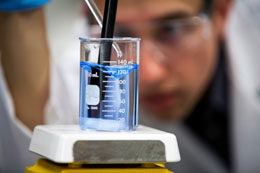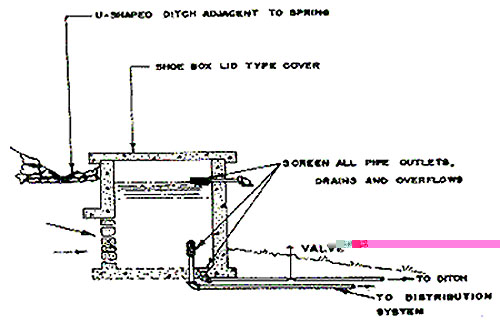
CONTACT:
Macon County Environmental Health
1830 Lakeside Drive, Franklin, NC 28734
Phone: (828) 349-2490
Fax: (828) 349-4136
email
Office Hours:
8:00 AM - 5:00 PM
Monday-Friday
| |
 Macon County Public Health Macon County Public Health
Environmental Health Services
Water Testing Information
The Macon County Public Health Center Laboratory tests samples of private drinking water for the presence of coliform bacteria and E. coli (Escherichia coli) bacteria. If the laboratory report on your drinking water indicates the presence of bacteria (Coliform Found or E. coli Found), it is recommended that the sources of contamination be eliminated and your water source be disinfected. Water contaminated with E. coli bacteria should not be used for drinking or cooking unless it is boiled for at least one minute or disinfected by other means.
Coliforms are a group of bacteria produced in, and hosted by, feces, soil, water, vegetation, and other matter. Within this group of total coliforms, there are fecal coliforms which are produced in warm-blooded animal intestinal tracts. Total coliforms, and particularly fecal coliforms, serve as indicators of possible pollution and potentially harmful organisms
E. coli (Escherichia coli) is a type of bacteria almost constantly present in the intestines of humans and other animals. Under certain conditions, E. coli can cause infections and illness.
Almost all surface waters contain some bacteria. Ground water is generally free of bacteria and should not need disinfecting unless it is directly contaminated by a waste source or an improperly constructed well. Surface water can get into wells as a result of leaky well covers, defective well-casing seals, or infiltration through side walls of dug wells. Contamination may also be introduced during the process of constructing or repairing a well.
The immediate remedy for bacteria contamination is to disinfect the water supply. Disinfection is only a temporary remedy; the most important consideration is to find and eliminate the source of the contamination.
Chlorination is the oldest method of continuous disinfection for water supplies. Disinfection by chlorination has been studied extensively, and there is a great body of experience upon which to draw. Chlorination is the standard by which other disinfection procedures are judged.
When chlorine is added to water several things occur. Almost immediately, it will oxidize inorganic materials, such as dissolved iron and manganese, and convert them to insoluble forms. Chlorine will also react with any organic matter present, usually breaking it down into more simple substances. Reactions with organic matter are much slower, and much longer contact between the organic matter and chlorine is necessary for the reactions to be completed. Finally, chlorine will kill bacteria.
The amount of chlorine consumed in these reactions is known as the "chlorine demand" of a water supply. The amount of chlorine remaining in the water after the chlorine demand is satisfied is known as the "free chlorine residual." Only if a chlorine residual is found in the water after adequate contact time is there assurance that disinfection has been completed.
Chlorine has its limitations. Its solutions are only moderately stable, organic matter as well as iron and manganese consume chlorine, high chlorine concentrations have objectionable tastes and odors, and even low chlorine concentrations react with some organic compounds to produce very strong, unpleasant tastes and odors. Chlorine use can also form trihalomethanes. Yet, in spite of these factors, chlorination is widely used on small private water systems.
Chlorine Sources: Many forms of chlorine are available, including ordinary laundry bleach. Laundry bleach normally contains five and one-fourth percent available chlorine, but the label should be checked for the percentage of chlorine and to see if cleaning agents have been added. Bleach with cleaning agents should NOT be used for disinfecting water supplies. Stronger solutions that contain 12 to 17 percent chlorine are also available. Normally used for swimming pool disinfection, they are also suitable for water treatment. Finally, there are powders and tablets. Dry chlorine sources range from 25 to 75 percent available chlorine. Dry chlorine sources are usually put into solutions prior to use, but tablets may be used directly for some applications.
Should you have any questions about these procedures or about your water system, you may contact the Macon County Public Health Center. Office hours are 8:00 a.m. to 5:00 p.m. Monday through Friday. To speak with an Environmental Health Specialist, please call between 8:00-9:00 a.m.
Instructions for Disinfection of Water Supply Wells
All water supplies should be disinfected upon completion of construction, maintenance, repairs, pump installation, and after a positive water test result.
You will need to know how deep your well is.
Use the following formula to determine the amount of water in the well.
A = Diameter of pipe or well tile in inches
B = Number of feet deep (well)
Formula: (A x A) x B x 0.041 = gallons of water
Example: 6' well and 100' deep
(6 x 6) x 100 x 0.041 = 148 gallons of water
Amount of chlorine to use: 3 ounces of hypochlorite per 100 gallons of water
Chlorination of Wells
- Chlorine should be placed in the well in sufficient quantities to produce a chlorine residual of at least 100 parts per million (ppm) in the well.
- A chlorine solution may be prepared by dissolving high-test calcium hypochlorite, 70% available chlorine, (HTH, Chlor-Tabs, etc.) in water. Hypochlorite is available where swimming pool chemicals are sold.
- Avoid using stabilized chlorine tablets or hypochlorite products containing fungicides, algaecides, or other disinfectants.
- Follow manufacturer directions for storing, transporting, and using calcium hypochlorite products. About three ounces of hypochlorite containing 65 percent to 75 percent available chlorine is needed per 100 gallons of water for at least a 100 ppm chlorine residual.
- Place the chlorine in the well by one of the following methods:
- Chlorine tablets may be dropped in the top of the well and allowed to settle to the bottom. -or-
- Unscrew the short vent pipe on top of the well casing. Use a funnel and pour the chlorine solution into the well.
- Agitate the water in the well to ensure thorough dispersion of the chlorine.
- The well casing, pump column, and any other equipment above the water level in the well should be thoroughly rinsed with the chlorine solution as part of the disinfecting process.
- The chlorine should stand in the well for a period of at least 24 hours.
- After 24 hours the well should be pumped to an outside faucet until the system is clear of the chlorine before the system is placed into use. Do not run water into sinks or bathtubs, as the chlorine can damage the septic system. Another coliform bacteria test is recommended after about 30 days or sooner, if no chlorination odor is detected.
Chlorination of Spring Reservoir
- Drain reservoir, if using a spring. (If reservoir has a pump inside, do NOT drain it completely.) Wash walls and bottom of reservoir. Use pure bleach and a stiff brush.
- Refill reservoir.
- Pour one pint of bleach per 100 gallons of water into the reservoir. Mix the bleach into the water. Turn on each faucet in the house one at a time until you can smell the bleach, then turn off the faucets. Let bleach stay in the pipes for a minimum of 12 hours.
- After 12 hours have passed, drain and refill reservoir. Turn on an outside faucet to clear the water lines of bleach. Do not run water into the sink or tub, because the bleach can damage the septic system. A small amount from the water lines inside the house will go into the septic system, but this cannot be avoided.
- Before using the water, let each inside faucet run until no strong bleach odor is detected. A slight chlorine smell and taste may be present in the water after chlorination; however, this will leave after a short period of time. Another coliform bacteria test is recommended after about 30 days, or sooner, if no chlorine odor is detected.
- See diagram for proper spring construction.

|
